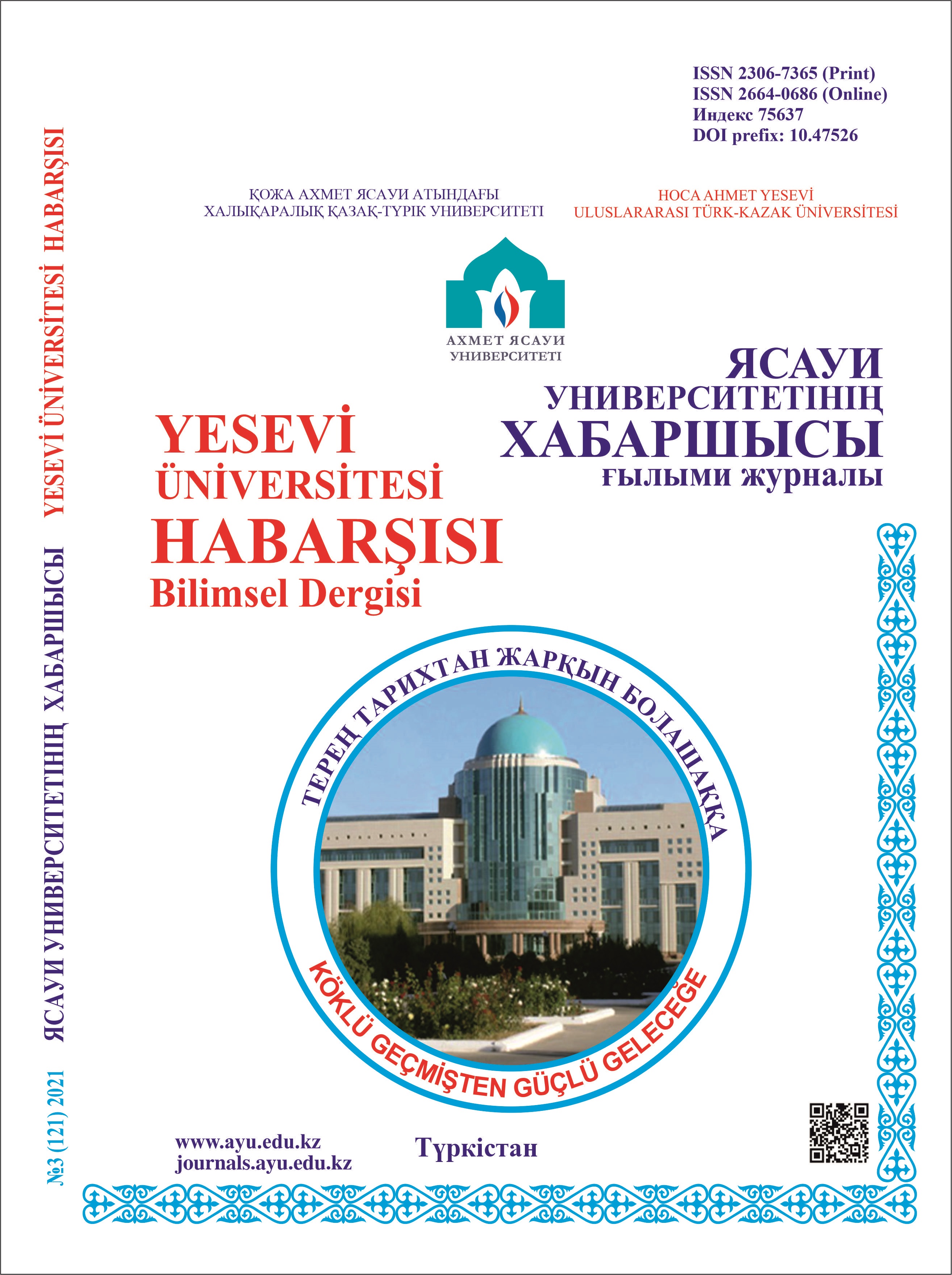KAZAK TÜRKÇESİ GÜNEY BÖLGESİ AĞZINDA SES OLAYLARI
133 104
Keywords:
Dialect, Southern Region, Phonetics, Phonetic Phenomena.Abstract
The most effective way to understand the historical development of languages, changes in vocabulary, and linguistic structures is through dialect studies. Dialects provide a rich source for tracking regional differences in the phonetic structure of a language and transformations throughout its historical processes. In this context, dialect research holds great importance, particularly in the analysis of phonetic phenomena. These phenomena help trace changes in a language's phonetic structure, helping us understand how it evolved from the past to the present.
Turkish, with its extensive geographical spread and historical diversity, provides a wealth of data for dialect research. Kazakh dialects spoken in the southern region of Kazakhstan are an important area of study in this context. The main goal of this study is to thoroughly examine the phonetic phenomena observed in these dialects. For this purpose, a study was conducted in 26 villages including Teke, Karnak, Karaşık, Savran, Kandöz, Şornak, Sultanbek Kojanov, Şiyeli, Kojakent, Özgent, Tügisken, Talap, Tömenarık, Beşarık, Kelintöbe, Köktöbe, Janaarık, Manap, Akjol, Ekpindi, Sunakata, Karatöbe, Maylıtogay, Tasböget, Otrar, Baltaköl. An attempt was made to reveal the differences between these dialects and Standard Kazakh Turkish, especially based on features such as the use of vowels, length, roundness, and width. For example, although there is no rounding phenomenon in Standard Kazakh Turkish, the sounds that follow are also rounded in the regional dialect due to the effect of the rounded vowel in the first syllable: jürüwgö ˂ jurwge “to walk”, ülkön ˂ ülken “big”, üydö ˂ üyde “at home”.
This examination aims not only to identify regional differences but also to assess the historical ties and geographic influences on the language. It is expected that the findings could offer a broader perspective on the phonetic structure of the Kazakh language and contribute to future comparative Turkishology studies. It is anticipated that the analysis of phonetic phenomena could lay a foundation for creating dialect atlases and understanding relationships between dialects.
References
KAYNAKLAR
Kaliyev G., Sarıbayev Ş. Kazak Diyalektolojisi // Uluslararası Araştırmalar Dergisi. - 2002. – Cilt 4, Sayı 9. – S. 221–238.
Sakhipova F. Kazak Türkçesinin Merkezȋ Kuzey ve Doğu (Orta Jüz) Ağızları: Yayımlanmamış Doktora Tezi. – Ankara: Ankara Üniversitesi Sosyal Bilimler Enstitüsü, 2007. – 1281 s. 3. Atmaca E. Kazak Türkçesi Ağızlarının Tasnifi Çalışmalarına Bir Bakış // Uluslararası Türkçe Edebiyat Kültür Eğitim Dergisi. – 2016. – Cilt 5, Sayı 2. – S. 589–625. https://dergipark.org.tr/tr/download/article-file/227877
İbragimov Zh. Siriderya boyu (Kızılorda-Türkistan) Kazak Ağızları: Yayınlanmamış Doktora tezi. – Muğla: Sosyal Bilimler Enstitüsü, 2020. – 778 s.
Banguoğlu T. Türkçenin Grameri. – Ankara: Türk Dil Kurumu, 2015. – 628 s.
Buran A., Alkaya E. Türk Lehçeleri. Ankara: Akçağ, 2013. 500 s.
Hacıeminoğlu N. Karahanlı Türkçesi Grameri. – Ankara: Türk Dil Kurumu, 1996. – 214 s.
Eckmann J. Harezm, Kıpçak ve Çağatay Türkçesi Üzerine Araştırmalar. – Ankara: Türk Dil Kurumu, 2014. – 438 s.
Akar A. Oğuzların Dili. – İstanbul: Ötüken, 2018. – 335 s.
Eckmann J. Çağatayca El Kitabı. – Ankara: Türk Dil Kurumu, 2017. – 232 s.
Koç K., Doğan O. Kazak Türkçesi Grameri. – Ankara: Gazi, 2004. – 440 s.
Исабаев А. Қазақ тілі дыбыс жүйесі методикасының негіздері. – Алматы: Мектеп, 1973. – 204 б.
Doğan O. Kazak Türkçesi Fonetiği. – İstanbul: İleri, 2015. – 560 s.
REFERENCES
Kaliyev G., Sarybayev Sh. Kazak Dialektolojisi [Kazakh Dialectology] // Uluslararası Araştırmalar Dergisi. – 2002. – Jilt 4, Saiy 9. – S. 221–238. [in Turkish]
Sahipova F. Kazak Turkchesinin Merkezi Kuzey ve Dogu (Orta Juz) Agyzlary: Yayımlanmamış Doktora Tezi [Central Northern and Eastern (Middle Juz) Dialects of Kazakh Language: Unpublished Doctoral Thesis]. – Ankara: Ankara Universitesi Sosyal Bilimler Enstitusu, 2007. – 1281 s. [in Turkish]
Atmaja E. Kazak Turkchesi Agyzlarynyn Tasnifi Chalyshmalaryna Bir Bakysh [An Overview of the Analysis of Dialects of the Kazakh language] // Uluslararasy Turkche Edebiyat Kultur Egitim Dergisi. – 2016. – Jilt 5, Saiy 2. – S. 589–625. https://dergipark.org.tr/tr/download/article-file/227877 [in Turkish]
Ibragimov J. Sirideria boiu (Kyzylorda-Turkistan) Kazak Agyzlary: Yayınlanmamış Doktora tezi [Syr Darya Tribe (Kızılorda-Turkestan) Kazakh Dialects: Unpublished Doctoral Thesis]. – Mugla: Sosial Bilimler Enstitusu, 2020. – 778 s. [in Turkish]
Banguoglu T. Turkchenin Grameri [Grammar of Turkish]. – Ankara: Türk Dil Kurumu, 2015. – 628 s. [in Turkish]
Buran A., Alkaia E. Turk Lehcheleri [Turkish Dialects]. Ankara: Akchag, 2013. 500 s. [in Turkish]
Hajieminoglu N. Karahanly Turkchesi Grameri [Grammar of the Karakhanid language]. – Ankara: Türk Dil Kurumu, 1996. – 214 s. [in Turkish]
Eckmann J. Harezm, Kypchak ve Chagatai Turkchesi Uzerine Arashtyrmalar [Studies on Khorezm, Kipchak and Chagatai languages]. – Ankara: Turk Dil Kurumu, 2014. – 438 s. [in Turkish]
Akar A. Oguzlaryn Dili [Language of Oghuz]. – Istanbul: Otuken, 2018. – 335 s. [in Turkish]
Eckmann J. Chagataija El Kitaby [Chagatai Handbook]. – Ankara: Turk Dil Kurumu, 2017. – 232 s. [in Turkish]
Koch K., Dogan O. Kazak Turkchesi Grameri [Kazakh Grammar]. - Ankara: Gazi. 2004. - s. 440. [in Turkish]
Isabaev A. Qazaq Tili Dybys Juiesi Metodikasynyn Negizderi [Methodology of the sound system of the Kazakh language]. – Almaty: Mektep, 1973. – 204 b. [in Kazakh]
Dogan O. Kazak Turkchesi Fonetigi [Kazakh Phonetics]. – Istanbul: Ileri, 2015. – 560 s. [in Turkish]

